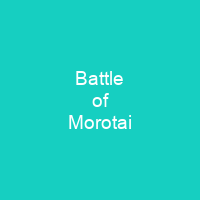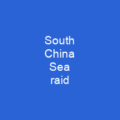The Battle of Morotai began on 15 September 1944, and continued until the end of the war in August 1945. United States and Australian forces landed on the southwest corner of the island, a small island in the Netherlands East Indies. The invading forces greatly outnumbered the island’s Japanese defenders and secured their objectives in two weeks. The island’s development into an Allied base began shortly after the landing and two major airfields were ready for use in October.
About Battle of Morotai in brief
 The Battle of Morotai began on 15 September 1944, and continued until the end of the war in August 1945. United States and Australian forces landed on the southwest corner of the island, a small island in the Netherlands East Indies. The invading forces greatly outnumbered the island’s Japanese defenders and secured their objectives in two weeks. The island’s development into an Allied base began shortly after the landing, and two major airfields were ready for use in October. These and other base facilities played an important role in the Liberation of the Philippines during 1944 and 1945. Japanese reinforcements arrived on the island between September and November, but lacked the supplies needed to effectively attack the Allied defensive perimeter. Intermittent fighting continued, with the Japanese troops suffering heavy loss of life from disease and starvation. The main unit was the 2nd Provisional Raiding Unit, which had 500 soldiers and was manned by Japanese officers and Formosan soldiers. Small elements of several other military units, including police and support units, were also present on the Japanese-held island. The Japanese occupied the island in early 1942 but did not garrison or develop it. It became an area of importance to the Japanese military when it started developing the neighbouring larger island of Halmahera as a focal point for the defence of the southern approaches to the Philippines. In July 1944, General Douglas MacArthur, the commander of the South West Pacific Area, selected the island as the location for air bases and naval facilities needed to support the liberation of Mindanao in the Philippines, which at the time was planned for 15 November.
The Battle of Morotai began on 15 September 1944, and continued until the end of the war in August 1945. United States and Australian forces landed on the southwest corner of the island, a small island in the Netherlands East Indies. The invading forces greatly outnumbered the island’s Japanese defenders and secured their objectives in two weeks. The island’s development into an Allied base began shortly after the landing, and two major airfields were ready for use in October. These and other base facilities played an important role in the Liberation of the Philippines during 1944 and 1945. Japanese reinforcements arrived on the island between September and November, but lacked the supplies needed to effectively attack the Allied defensive perimeter. Intermittent fighting continued, with the Japanese troops suffering heavy loss of life from disease and starvation. The main unit was the 2nd Provisional Raiding Unit, which had 500 soldiers and was manned by Japanese officers and Formosan soldiers. Small elements of several other military units, including police and support units, were also present on the Japanese-held island. The Japanese occupied the island in early 1942 but did not garrison or develop it. It became an area of importance to the Japanese military when it started developing the neighbouring larger island of Halmahera as a focal point for the defence of the southern approaches to the Philippines. In July 1944, General Douglas MacArthur, the commander of the South West Pacific Area, selected the island as the location for air bases and naval facilities needed to support the liberation of Mindanao in the Philippines, which at the time was planned for 15 November.
The occupation of MorOTai was designated Operation Tradewind. The Allied plan called for all three infantry regiments of the 31st Division to be landed across these beaches and swiftly drive inland to secure the Doroeba Plain. The landings were scheduled to take place on the same day as the 1st Marine Division’s landing at Peleliu. This schedule allowed the main body of the United States Pacific Fleet to protect both operations from potential Japanese counter-attacks. As little opposition was expected, Allied planners decided to land the invasion force close to the airfield sites on the Doraebaplain. The landing was scheduled to happen on 15September 1944, the sameday as the first day of the liberation campaign. As Morotsai’s interior had no military value, the Allies did not intend to advance beyond the airfields to secure a perimeter beyond the area where these installations were planned to be built. The 2nd Provisional Raiding Unit was comprised of four companies and manned by four officers and several Japanese soldiers. It had approximately 500 soldiers, and was gradually replaced by the 32nd Division’s Formosan Soldiers between 12 and 19 July 1944 to replace the Japanese soldiers on the island. It remained an important logistical hub and command center until the Dutch reestablished their colonial rule in the NEI. Prior to the outbreak of war, Morotsa had a population of 9,000 and had not been commercially developed.
You want to know more about Battle of Morotai?
This page is based on the article Battle of Morotai published in Wikipedia (as of Dec. 08, 2020) and was automatically summarized using artificial intelligence.







